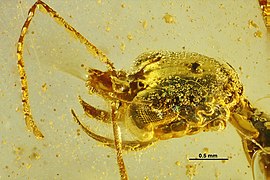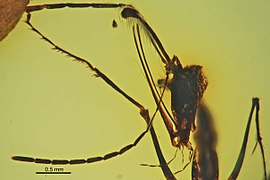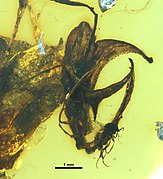| Haidomyrmecinae | |
|---|---|

| |
| Dhagnathos autokrator | |
|
Scientific classification
| |
| Domain: | Eukaryota |
| Kingdom: | Animalia |
| Phylum: | Arthropoda |
| Class: | Insecta |
| Order: | Hymenoptera |
| Family: | Formicidae |
| Subfamily: | †
Haidomyrmecinae Bolton, 2003 |
| Type genus | |
| †
Haidomyrmex | |
| Genera | |
|
See text | |
| Synonyms | |
| |
Haidomyrmecinae, occasionally called hell ants, are an extinct subfamily of ants (Formicidae) known from Cretaceous fossils found in ambers of North America, Europe, and Asia, spanning the late Albian to Campanian, around 100 to 79 million years ago. The subfamily was first proposed in 2003, but had been subsequently treated as the tribe Haidomyrmecini and placed in the extinct ant subfamily Sphecomyrminae. Reevaluation of the Haidomyrmecini in 2020 lead to the elevation of the group back to subfamily. The family contains the nine genera and 13 species. [1]
Members of this family are highly distinct from all other ants, having diverse head ornamentation, and unusually shaped, extended mandibles that articulated vertically rather than horizontally as in modern ants. The jaws in combination with the head ornamentation served to restrain prey, with most species having setae (hair-like structures) covering parts of the head, which likely functioned as triggers to rapidly close the jaw when disturbed, similar to those of modern trap-jaw ants. Fossils indicate that haidomyrmecines were able to take prey solitarily. [2] Like modern ants, they were eusocial, with distinct worker and queen castes, [2] likely with relatively small colony sizes. [3] Due to their lack of metabolic stores, it is likely that the queens engaged in hunting during the initial foundation of the nest. [4] Haidomymecines are thought to be amongst the most basal and earliest diverging group of ants known. [1]
Genera


Including the type genus Haidomyrmex, the subfamily contains 10 genera and 14 species.
The vast majority of species are known from Burmese amber, which dates to the mid-Cretaceous, around 100 million years ago. Other species are known from French amber of equivalent age, as well as the Canadian amber of Alberta, Canada, which dates to around 80 million years ago.
-
Aquilomyrmex Perrichot et al., 2020
- A. huangi Perrichot et al., 2020
-
Ceratomyrmex Perrichot, Wang & Engel, 2016
- Ce. ellenbergeri Perrichot, Wang & Engel, 2016
-
Chonidris Perrichot et al., 2020
- Ch. insolita Perrichot et al., 2020
-
Dhagnathos Perrichot et al., 2020
- Dh. autokrator Perrichot et al., 2020
-
Dilobops Lattke & Melo, 2020
- Di. bidentata Lattke & Melo, 2020
-
Haidomyrmex Dlussky, 1996
- Hx. cerberus Dlussky, 1996
- Hx. scimitarus Barden & Grimaldi, 2012
- Hx. zigrasi Barden & Grimaldi, 2012
-
Haidomyrmodes Perrichot et al., 2008
- Hs. mammuthus Perrichot et al., 2008
-
Haidoterminus McKellar, Glasier & Engel, 2013
- Ht. cippus McKellar, Glasier & Engel, 2013
-
Linguamyrmex Barden & Grimaldi, 2017
- L. brevicornis Perrichot et al., 2020
- L. rhinocerus Miao & Wang, 2019
- L. vladi Barden & Grimaldi, 2017
-
Protoceratomyrmex Perrichot et al., 2020
- P. revelatus Perrichot et al., 2020
References
- ^ a b Perrichot, V.; Wang, B.; Barden, P. (2020). "New remarkable hell ants (Formicidae: Haidomyrmecinae stat. nov.) from mid-Cretaceous amber of northern Myanmar" (PDF). Cretaceous Research. 109: 104381. Bibcode: 2020CrRes.10904381P. doi: 10.1016/j.cretres.2020.104381.
- ^ a b Barden, Phillip; Perrichot, Vincent; Wang, Bo (October 2020). "Specialized Predation Drives Aberrant Morphological Integration and Diversity in the Earliest Ants". Current Biology. 30 (19): 3818–3824.e4. Bibcode: 2020CBio...30E3818B. doi: 10.1016/j.cub.2020.06.106. PMID 32763171.
- ^ Perrichot, Vincent; Wang, Bo; Engel, Michael S. (June 2016). "Extreme Morphogenesis and Ecological Specialization among Cretaceous Basal Ants". Current Biology. 26 (11): 1468–1472. Bibcode: 2016CBio...26.1468P. doi: 10.1016/j.cub.2016.03.075. PMID 27238278.
- ^ Barden, Phillip; Grimaldi, David A. (February 2016). "Adaptive Radiation in Socially Advanced Stem-Group Ants from the Cretaceous". Current Biology. 26 (4): 515–521. Bibcode: 2016CBio...26..515B. doi: 10.1016/j.cub.2015.12.060. PMID 26877084.
External links
- The Reign of the Hell Ants PBS Eons, Jan 21, 2021









